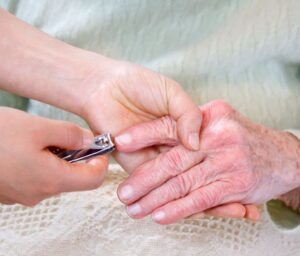 Nails change with age, whether they develop a thickened, yellow appearance, become more vulnerable to fungal infections or thin and flake off.
Nails change with age, whether they develop a thickened, yellow appearance, become more vulnerable to fungal infections or thin and flake off.
While brittle nails can affect anyone, older adults are more susceptible to this condition characterized by splitting, peeling or visible breakage. Learn why this occurs and what you can do to address the issue.
When Are Nails Brittle?
Nails are made of a protein called keratin that protects your fingers and toes from damage. Nails form and grow out of the base of your finger and a layer of skin protects this area against infections.
Ideally, your nails have a shiny, smooth appearance with white edges and a curved shape. The nail bed, distinct from the cuticle, should appear pink.
Nails are characterized as brittle when:
- The ridge is angled 90 degrees from the fold
- Cracks and dents form on the open edge
- Splitting occurs along the ridges
- Discoloration is present, including a lighter color on top or a dark shade below
- The nail starts to curl
- The keratin feels thin or begins to separate from the skin
- Bleeding or swelling occurs around the nail
- The nail does not grow out from the bed
Causes of Brittle Nails
Brittle nails may occur in response to an underlying health condition or lifestyle factors. Potential causes include:
- Repeatedly washing your hands, which can cause the nails to dry out and break.
- Exposure to household chemicals, including soaps, cleaners and nail polish remover.
- Age, which can affect keratin production and nail growth. These two factors can result in thin fingernails that break easily.
- A nutritional deficiency, with low iron, protein, biotin, calcium, fatty acid and vitamin B levels associated with nail thinning and breakage.
- Regularly filing and manicuring your nails, which can contribute to cracks and splits.
- Hypothyroidism, which may be accompanied by hair loss, fatigue and weight gain.
- Raynaud’s syndrome, which affects circulation and how nutrients reach the extremities, including your nails.
- A fungal infection causing your nails to separate from the bed.
- Psoriasis, which can result in plaques forming under the nails, contribute to discoloration and cause the nail to separate from the bed.
- Damage to the nail bed, which can affect the cells responsible for growth.
- Living in a dry or cold environment.
- Hormonal changes, with menopause potentially causing pale, dull or thinning nails.
How to Preserve Your Nails
To help prevent your nails from splitting and breaking:
- Moisturize your nails, especially after washing your hands or doing the dishes
- Moisturize your hands and feet before you go to sleep
- Protect your hands while doing household chores with a pair of rubber gloves
- Limit using alcohol-based sanitizers, which can dry out your nails
- Put on insulating gloves if you need to head outside into cold, wet weather
- Keep your nails short to limit snagging and breakage
- File the edges in a single direction to keep your nails even and lessen splitting
- Avoid biting your nails or using them as a pick
- Avoid using a nail polish remover containing acetone
- Lessen how often you paint your nails or get acrylics, both of which can wear down the surface of your natural nails
- Start consuming more protein and take a biotin supplement
Are you concerned about your own or a loved one’s nail health? Bring your questions to the medical team at Avon Health Center today.
« How Do Bedsores Develop?

